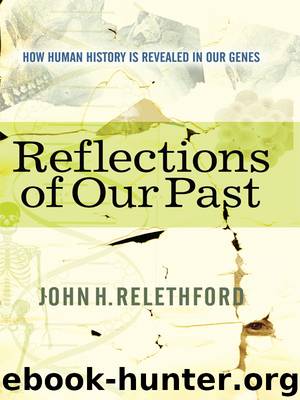Reflections of Our Past by John H Relethford

Author:John H Relethford [JOHN H. RELETHFORD]
Language: eng
Format: epub
Publisher: Westview Press
Published: 2012-01-01T05:00:00+00:00
Although these examples are certainly suggestive, are they sufficient by themselves to demonstrate a historical link between Asians and Native Americans? Perhaps shovel-shaped incisors and the Diego blood group are the exceptions rather than the rule. As I noted in previous chapters, not all biological traits provide the same picture. Natural selection can make distantly related populations appear more similar (as in the previous examples of skin color) and make closely related populations appear less similar. There is also the ever-present problem of sampling error; we should avoid making too much out of any single trait, but instead focus on the more statistically accurate picture that can be achieved by averaging results. In the case of the origin of the first Americans, we should examine average patterns of genetic distance, based on many different traits. This has been done in a variety of analyses, ranging from studies of cranial shape to blood groups to DNA markers, and the results consistently support a close genetic and historical link between the Americas and Asia, specifically northeastern Asia.
One good example of this type of genetic distance study, described in the previous chapter, is the comprehensive analysis performed by Cavalli-Sforza and his colleagues using frequencies of classic genetic markers from populations across the world.7 These results show a close genetic relationship between Native Americans and Asian populations, particularly Arctic Northeast Asians (see Figure 5.2, for example). This can be seen more clearly by looking only at the genetic distances of other groups of humanity to Native Americans. Figure 6.3, from Cavalli-Sforza’s analysis, shows these genetic distances. The shortest genetic distance (showing the closest similarity) is to Arctic Northeast Asians, followed by other Northeast Asians. As with other traits and analyses, the connection between Northeast Asia and the Americas is quite clear.
Although studies of classic genetic markers confirm the broad picture of a Northeast Asian connection, by themselves they do not provide great specificity. Additional insight has been gained in recent years through the analysis of mitochondrial DNA. By focusing on mitochondrial DNA, with its strict maternal inheritance, we avoid the problems of traits inherited from both parents, where there is recombination of the genetic material each generation. By looking at the evolutionary history of mitochondrial DNA, we can get a clearer picture, at least through the maternal line, of the origins of the first Americans.
One of the ways in which mitochondrial DNA is used to reconstruct population history is through the geographic analysis of mitochondrial haplotypes, which are combinations of genes that are inherited together as a single unit (the root “haplo” means single). All of your mitochondrial DNA is inherited as a single unit from your mother. Haplotype analysis starts by using the restriction fragment length polymorphisms (RFLPs), which were described briefly in the previous chapter. DNA is exposed to certain bacterial enzymes that identify specific configurations in the DNA sequence known as restriction sites. There are a number of different restriction enzymes, each one targeted to a specific sequence of DNA bases.
Download
This site does not store any files on its server. We only index and link to content provided by other sites. Please contact the content providers to delete copyright contents if any and email us, we'll remove relevant links or contents immediately.
| Anthropology | Archaeology |
| Philosophy | Politics & Government |
| Social Sciences | Sociology |
| Women's Studies |
Cecilia; Or, Memoirs of an Heiress — Volume 1 by Fanny Burney(32375)
Cecilia; Or, Memoirs of an Heiress — Volume 3 by Fanny Burney(31750)
Cecilia; Or, Memoirs of an Heiress — Volume 2 by Fanny Burney(31716)
The Great Music City by Andrea Baker(31087)
We're Going to Need More Wine by Gabrielle Union(18906)
All the Missing Girls by Megan Miranda(15398)
Pimp by Iceberg Slim(14219)
Bombshells: Glamour Girls of a Lifetime by Sullivan Steve(13928)
Talking to Strangers by Malcolm Gladwell(13134)
Norse Mythology by Gaiman Neil(13132)
Fifty Shades Freed by E L James(13122)
For the Love of Europe by Rick Steves(12349)
Crazy Rich Asians by Kevin Kwan(9125)
Mindhunter: Inside the FBI's Elite Serial Crime Unit by John E. Douglas & Mark Olshaker(9106)
The Lost Art of Listening by Michael P. Nichols(7360)
Enlightenment Now: The Case for Reason, Science, Humanism, and Progress by Steven Pinker(7085)
The Four Agreements by Don Miguel Ruiz(6542)
Bad Blood by John Carreyrou(6477)
Weapons of Math Destruction by Cathy O'Neil(6085)
